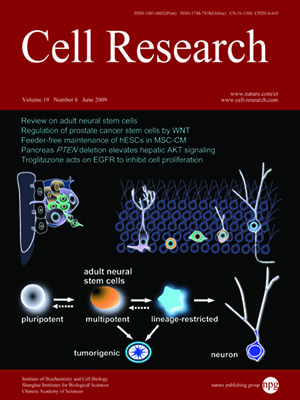
Volume 19, No 6, Jun 2009
ISSN: 1001-0602
EISSN: 1748-7838 2018
impact factor 17.848*
(Clarivate Analytics, 2019)
Volume 19 Issue 6, June 2009: 783-792
ORIGINAL ARTICLES
The adenoviral E1A protein displaces corepressors and relieves gene repression by unliganded thyroid hormone receptors in vivo
Yukiyasu Sato1,2, Andrew Ding1, Rachel A Heimeier1, Ahmed F Yousef3, Joe S Mymryk3, Paul G Walfish4 and Yun-Bo Shi1
1Section on Molecular Morphogenesis, Laboratory of Gene Regulation and Development, PCRM, NICHD, NIH, Bldg 18T, Rm 106, Bethesda, MD 20892, USA
2Obstetrics Division, Department of Gynecology & Obstetrics, Kyoto University Graduate School of Medicine, Sakyo-ku, Kyoto 606-8507, Japan
3Departments of Oncology and Microbiology & Immunology, The University of Western Ontario, London, Ontario, Canada N6A 4L6
4Endocrine Division, Department of Medicine, Room 413, Mount Sinai Hospital, 600 University Avenue, Toronto, Ontario, Canada M5G 1X5
Correspondence: Yun-Bo Shi, Paul G Walfish,(Shi@helix.nih.gov; walfish@mshri.on.ca)
The human adenovirus type 5 early region 1A (E1A) is one of two oncogenes present in the adenovirus genome and functions by interfering with the activities of cellular regulatory proteins. The E1A gene is alternatively spliced to yield five products. Earlier studies have revealed that E1A can regulate the function of thyroid hormone (T3) receptors (TRs). However, analysis in yeast compared with transfection studies in mammalian cell cultures yields surprisingly different effects. Here, we have examined the effect of E1A on TR function by using the frog oocyte in vivo system, where the effects of E1A can be studied in the context of chromatin. We demonstrate that different isoforms of E1A have distinct effects on TR function. The two longest forms inhibit both the repression by unliganded TR and activation by T3-bound TR. We further show that E1A binds to unliganded TR to displace the endogenous corepressor nuclear receptor corepressor, thus relieving the repression by unliganded TR. On the other hand, in the presence of T3, E1A inhibits gene activation by T3-bound TR indirectly, through a mechanism that requires its binding domain for the general coactivator p300. Taken together, our results thus indicate that E1A affects TR function through distinct mechanisms that are dependent upon the presence or absence of T3.
Cell Research (2009) 19:783-792. doi: 10.1038/cr.2009.55; published online 12 May 2009
FULL TEXT | PDF
Browse 1852


